These East India Company coins are known to be fakes. Whatever is written about the mintage or origin of the coins is just make believe stories to make things interesting. The one anna coin shown here has the same design, material and size with different dates written on it. Apart from the coins shown, I recently came across similar coins with date of 1616 and also 1939 written on it! Apparently the faker forgot the period for which the East India Company ruled India. We know that 1616 was in the Jahangir era and the East India Company did not rule India then, though it did set up trade. And in 1939, we know very well that in 1939, George VI was the emperor of India and India was very close to getting its independence. So there is no way these coins had been in circulation in the East India company era, that is established beyond doubt. The deities on these coins are worshipped, but the East India Company never had any reason to mint coins having these deities on them , and never did so.
Very soon I will be putting up the coins that were actually in circulation during the rule of the East India company, the real Mccoy.
This picture is used to show the size of a one anna coin circulated in 1818 by the East India Company. An Indian one rupee coin minted in 1988 by the Indian Government is used as a scale. This one rupee coin is slightly larger than the one rupee coin minted currently. 16 annas make one rupee, so i think that just goes to show the effect of inflation here.

Half anna , 1717
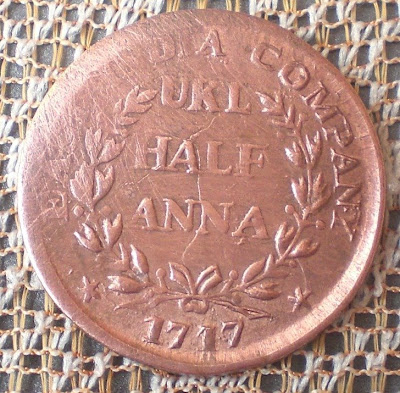
The reverse of the 1717 half anna circulated by the East India company. About Good(AG) condition. We can see a crack in the middle of the coin. This may be an error in the production of the coin.
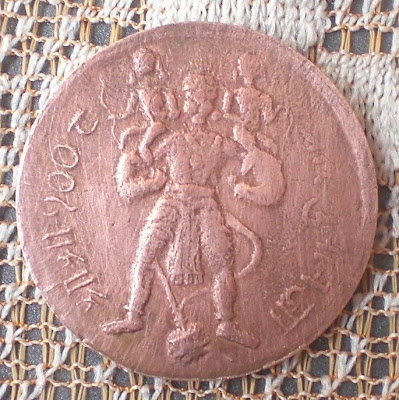
The obverse shows hanuman, the devotee of Rama.He wields a mace and symbolizes devotion and strength. He does various feats like crossing a sea and locating sita in the enemy territory. Also, during the battle a certain herb, the sanjivani is needed for the wounded lakshamana. Hanuman goes to find it but does not know which herb is it. So he shows his strength in lifting the entire mountain, and brings the sanjivani along with the mountain.
On the right we can see "shree shree 1007" written in hindi. Rest is quite worn out so it is hard to read.
East India company one anna, 1839 - Rama

The reverse of the 1839 one anna coin used as currency by the East India Company.
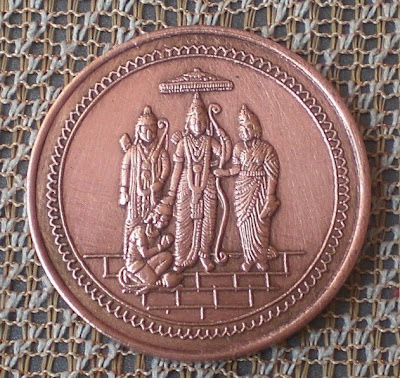
The obverse of this coin shows Lord Rama in the centre, holding his bow and arrow (which was a question to Jamal Malik in the movie Slumdog Millionaire). To our right is his wife Sita, to the left is his brother Laxmana, and the one bowing is the devotee, Hanuman. Rama was a legendary king in ancient India with his capital at Ayodhya, and he was one of the avatars of Lord Vishnu, one who supports, sustains and governs the universe. The four in the above picture are the central characters in the Hindu epic Ramayana, composed by Valmiki. In the epic, Rama battles Ravana and this battle symbolizes the battle between good and evil.
East India Company one anna , 1818 - Saraswati
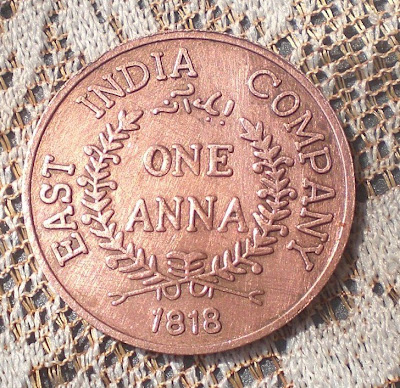
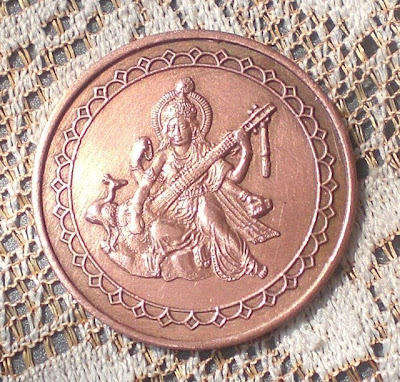
The obverse of this coin is showing Saraswati, the goddess of knowledge, music and arts. She has been identified with the river Saraswati. The most prominent theory regarding the now extinct Saraswati river is that it was formed of the present Yamuna river, which flowed West instead of East after Paonta Sahib, and flowed roughly parallel to the Indus river. The Harappan civilization flourished between the Indus and the Saraswati. Between 2000 B.C. and 1700 B.C., seismic activity caused the waters of the river's two main sources to change course.The Sutlej moved course westward and became a tributary of the Indus River. The Yamuna moved course eastward and became a tributary of the Ganges. The tremendous loss of water which resulted from these movements caused the once mighty river to become sluggish and dry up in the Thar Desert without ever reaching the sea. Without any water for irrigation or transportation, the dense population of the river basin soon shifted east with the waters of the Yamuna to the Ganges River valley. Late Vedic texts record the river as disappearing at Vinasana (literally, "the disappearing"), and as joining both the Yamuna and Ganges as an invisible river. Some claim that the sanctity of the modern Ganges is directly related to its assumption of the holy, and supposedly life-giving waters of the ancient Saraswati.
Of late, vestiges of the great river have been found through satellite imaging.
East India Company one anna , 1818 - Shiva
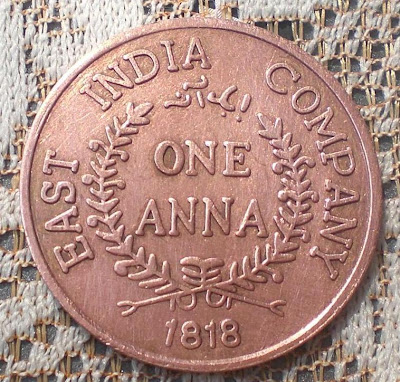

East India Company 1818 one anna. The obverse of this 1818 east india company has the lord shiva on its obverse. shiva is revered as the destroyer in Hindu mythology. shiva is usually worshipped in the form of Shiva linga. In images, he is generally represented as immersed in deep meditation or dancing the Tandava, the dance of destruction. He also has a wife, Parvati, also called Uma, and two sons, Ganesh and Karthikeya.
 2. Sir James Braid Taylor - July 1, 1937 to February 17,1943
2. Sir James Braid Taylor - July 1, 1937 to February 17,1943















































